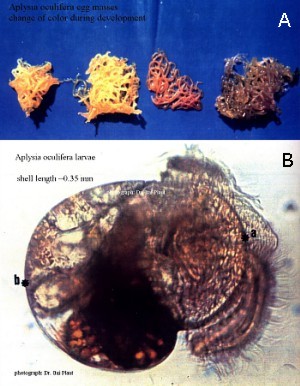
Egg colour variation
PHOTO
Colour change in egg ribbon of Aplysia oculifera from freshly laid (bright yellow) to a brown just before hatching. B. Veliger larvae - shell length 0.35mm. Photos: Itai Plaut.
Many opisthobranch egg masses are white but there are some some groups in which the individual eggs and so the egg ribbon are brightly coloured. There is some evidence to suggest that eggs are protected by the incorporation of anti-feedant molecules into the ribbon but clearly a lot more work needs to be done before we have a good understanding about the function, if any, of colour in their egg ribbons. We also need to understand where the egg ribbbons are deposited as well. For example the bright red spectacular eggs ribbon of Hexabranchus sanguineus [see message #5160] is obvious to all potential predators, while the equally bright red egg ribbon of species of Rostanga [see Rostanga bifurcata] appear to be examples of cryptic camouflage closely matching the colour of the sponge prey on which they are deposited. In the case of Rostanga the colour of the egg ribbons vary slightly in colour to closely match the section of the sponge on which they are laid. This suggests that the egg colour is food derived but I know of no direct evidence for this hypothesis.
At least in some species, egg ribbons change colour as the embryos develop. Species of Aplysia commonly do this as illustrated here by [A. oculifera]. Some nudibranchs do as well [see Rostanga calumus - #6795] and so do sacoglossans [see #1303].
Authorship detailsRudman, W.B., 2002 (August 2) Egg colour variation. [In] Sea Slug Forum. Australian Museum, Sydney. Available from http://www.seaslugforum.net/factsheet/eggscolvar
